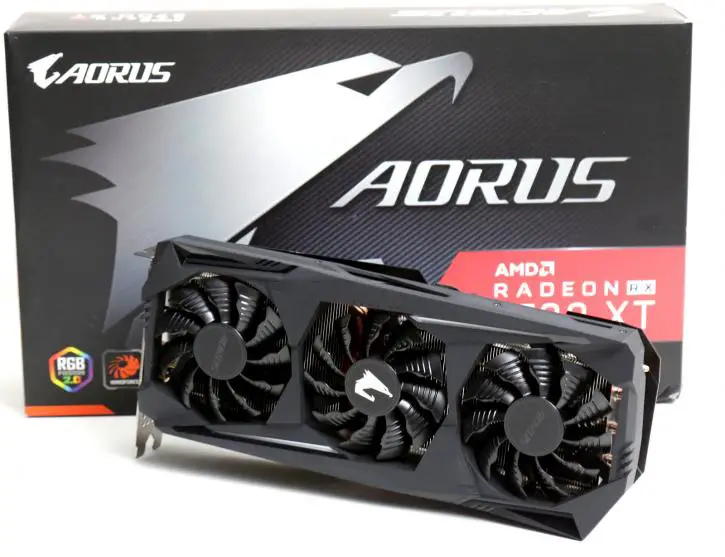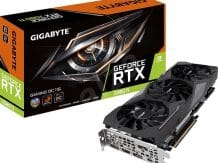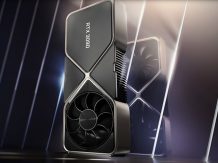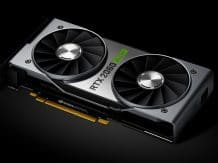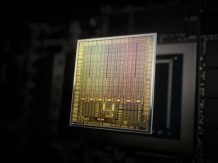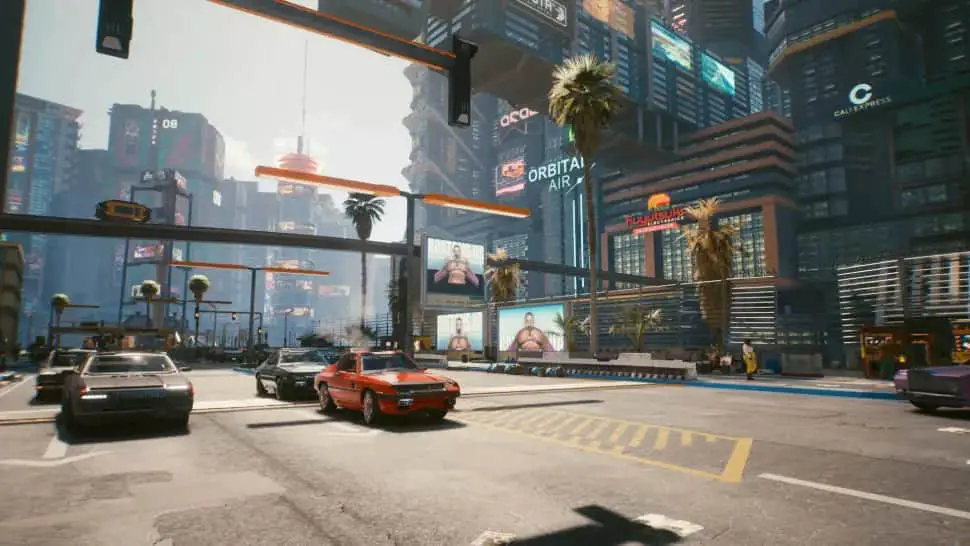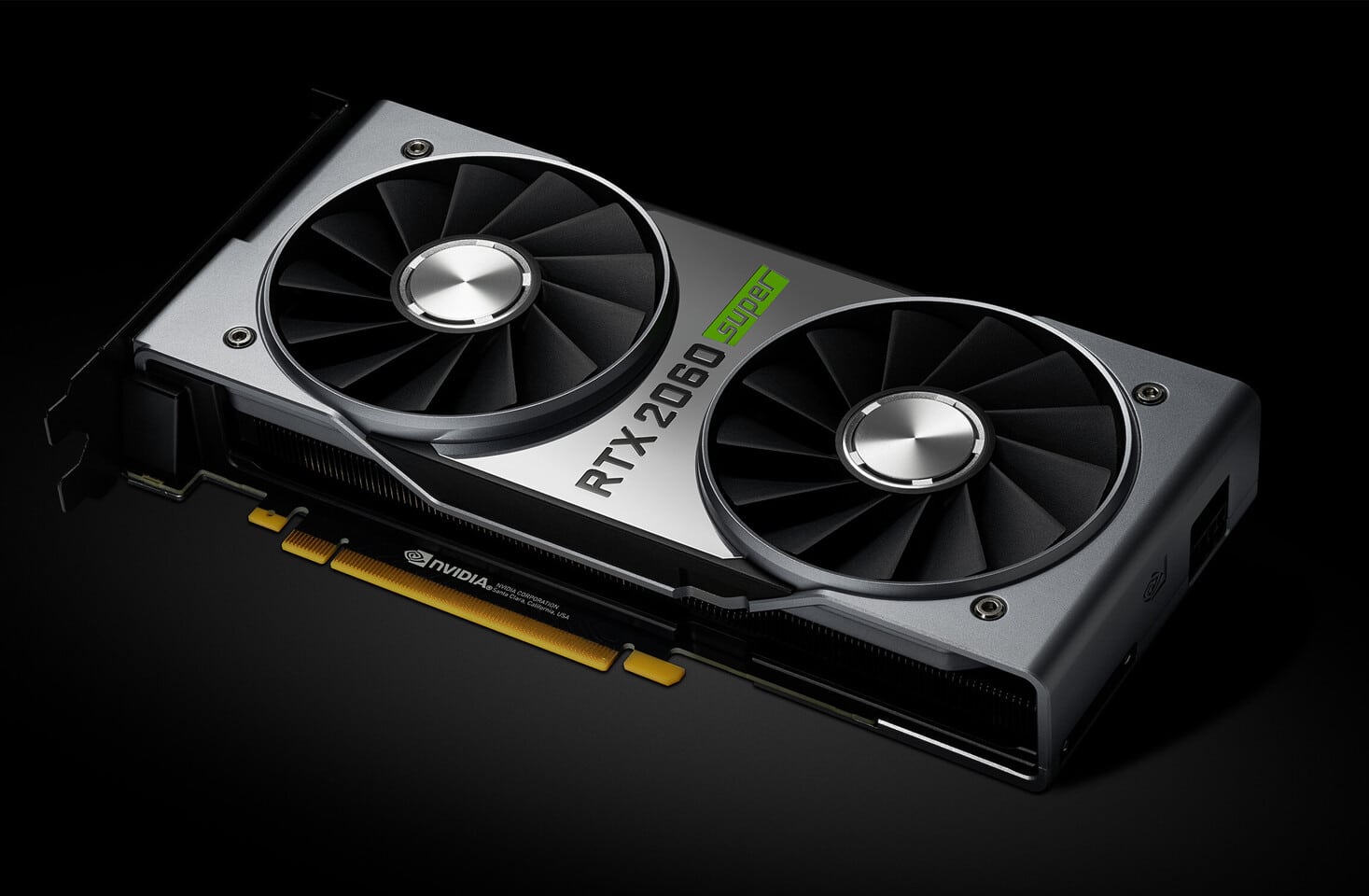Review of the video card Gigabyte Aorus Radeon RX 5700 XT 8G (8 GB): Hashrate | Benchmark| Overclocking Settings. Learn about some of the best information about how this Bitcoin miner performs over testing’s.
Subject of research : A commercially available 3D graphics accelerator (video card) Gigabyte Aorus Radeon RX 5700 XT 8G 8GB 256-bit GDDR6
Briefly about the main thing
At the beginning of all reviews of serial video cards, we update our knowledge about the performance of the accelerator family and its competitors. All this is subjectively assessed by us on a scale of five gradations.
Whether you need hardware ray tracing or not, whether smart tensors are useful, except for the special anti-aliasing mode of Nvidia GeForce – these are difficult questions, there are no definite answers to them.
But if you look at the performance in 3D without taking into account all of the above, then our tests showed that, in general, the Radeon RX 5700 XT accelerators are about the level of the GeForce GTX 1080 Ti and are slightly below the GeForce RTX 2070 Super (RTX 2070 is left behind).
According to our research, such accelerators are perfect for most games in resolutions up to 2560 × 1440 inclusive when using the maximum graphics quality, and with this accelerator you can get some comfort in games in 4K resolution (with the same maximum settings), although already, of course , not at all.
Card characteristics
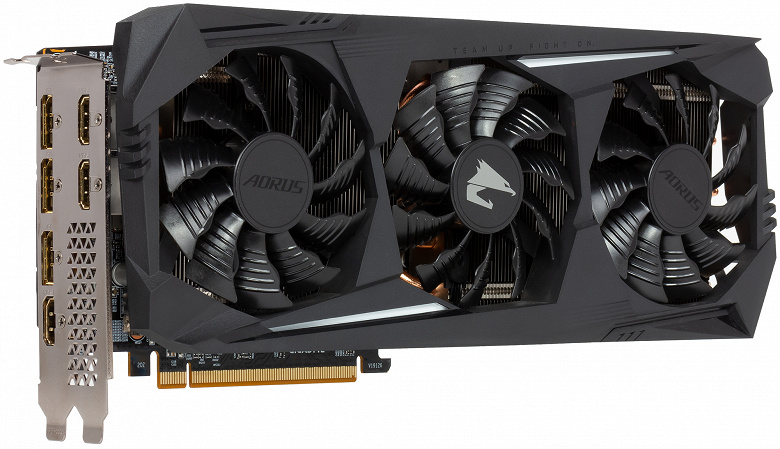
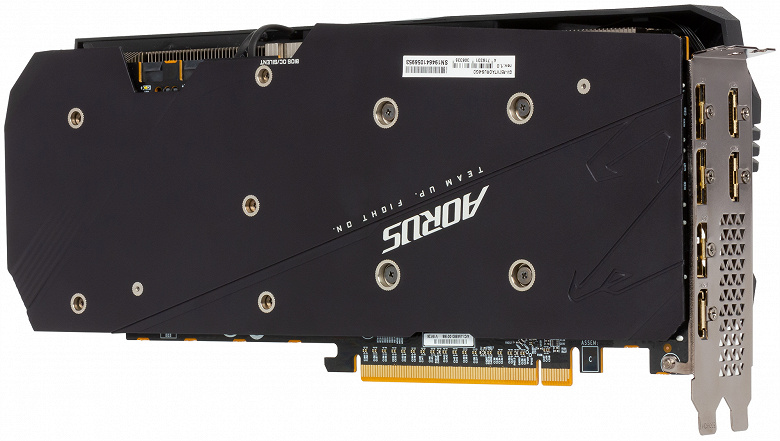
Gigabyte Technology (Gigabyte trademark) was founded in 1986 in the Republic of China (Taiwan). Headquartered in Taipei / Taiwan. It was originally created as a group of developers and researchers. In 2004, on the basis of the company, the Gigabyte holding was formed, which included Gigabyte Technology (development and production of video cards and motherboards for PCs); Gigabyte Communications (production of communicators and smartphones under the GSmart brand (since 2006).
| Gigabyte Aorus Radeon RX 5700 XT 8G 8GB 256-bit GDDR6 | ||
|---|---|---|
| Parameter | Meaning | Nominal value (reference) |
| GPU | Radeon RX 5700 XT (Navi 10) | |
| Interface | PCI Express x16 | |
| GPU frequency (ROPs), MHz | 1775—1905(Game/Boost)—1990(Max) | 1605—1755(Game/Boost)—1905(Max) |
| Memory frequency (physical (effective)), MHz | 3500 (14000) | 3500 (14000) |
| Memory bus width, bit | 256 | |
| GPU Computing Units | 40 | |
| Number of operations (ALU) per block | 64 | |
| Total number of ALUs | 2560 | |
| Texture units (BLF / TLF / ANIS) | 160 | |
| ROP units | 64 | |
| Number of Ray Tracing blocks | — | |
| Number of tensor blocks | — | |
| Dimensions, mm | 295×110×60 | 220×100×36 |
| The number of slots in the system unit occupied by the video card | 3 | 2 |
| PCB color | black | black |
| Peak power consumption in 3D, W | 224 | 219 |
| Power consumption in 2D mode, W | 25 | 22 |
| Power consumption in sleep mode, W | 3 | 3 |
| Noise level in 3D (maximum load), dBA | 29,0 | 42,2 |
| Noise level in 2D (video viewing), dBA | 18,0 | 19,0 |
| Noise level in 2D (idle), dBA | 18,0 | 19,0 |
| Video outputs | 3×HDMI 2.0b, 3×DisplayPort 1.4 | 1×HDMI 2.0b, 3×DisplayPort 1.4 |
| Multiprocessor support | No | |
| Maximum number of receivers / monitors for simultaneous image display | 6 (AMD Eyefinity) | 4 |
| Power: 8-pin connectors | 2 | 1 |
| Power supply: 6-pin connectors | 0 | 1 |
| Max Resolution / Frequency, DisplayPort | 3840 × 2160 @ 120Hz (7680 × 4320 @ 30Hz) | |
| Max Resolution / Frequency, HDMI | 3840 × 2160 @ 60Hz | |
| Max Resolution / Frequency, Dual-Link DVI | 2560 × 1600 @ 60Hz (1920 × 1200 @ 120Hz) | |
| Max Resolution / Frequency, Single-Link DVI | 1920 × 1200 @ 60Hz (1280 × 1024 @ 85Hz) | |
| Gigabyte card retail prices |
Memory
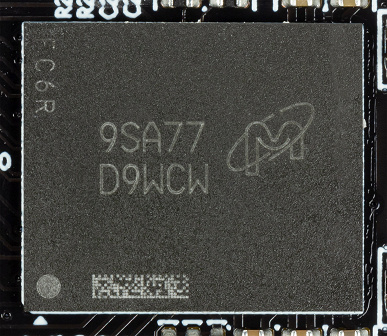
The card has 8 GB of GDDR6 SDRAM located in 8 8 Gbit chips on the front side of the PCB. Micron memory chips (GDDR6, MT61K256M32JE-14) are designed for a nominal operating frequency of 3500 (14000) MHz. The decryptor of codes on FBGA packages is here.
Card features and comparison with reference design
| Gigabyte Aorus Radeon RX 5700 XT 8G (8G) | AMD Radeon RX 5700 XT (8 ГБ) |
|---|---|
| front view | |
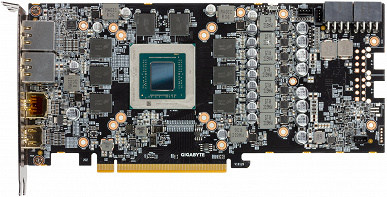 | 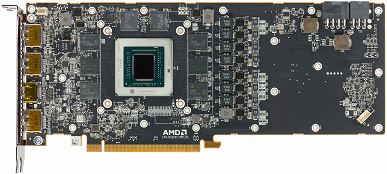 |
| back view | |
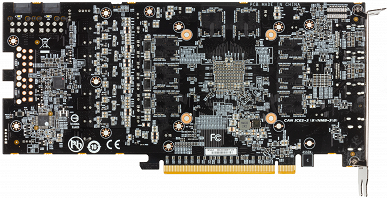 | 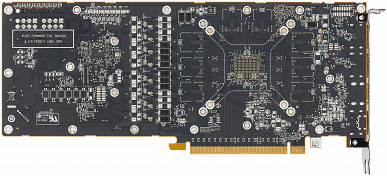 |
It is obvious that the PCB of the Gigabyte card differs significantly from the reference sample. This applies not only to a slightly redesigned power supply system, but also to a changed set of video outputs.
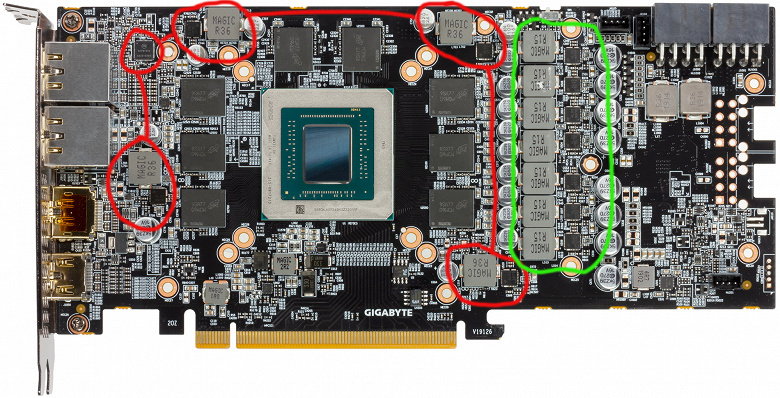
Core power supply circuit – 7-phase (marked in green),
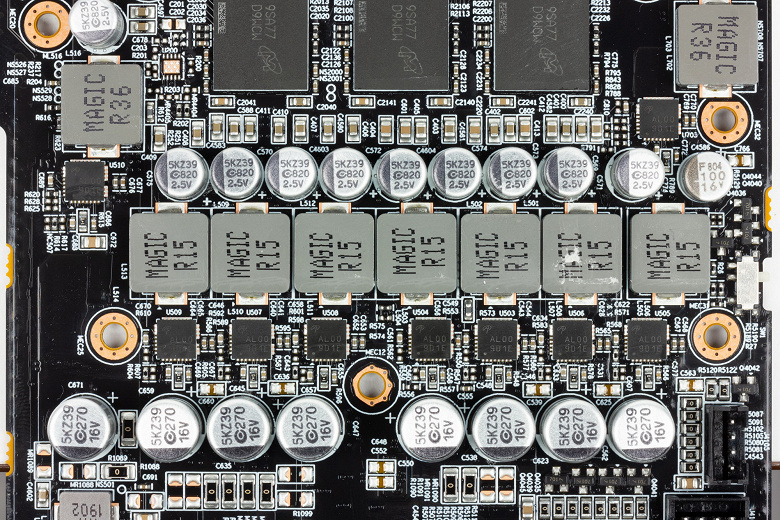
It is controlled by the International Rectifier (Infineon) IR35217 PWM controller. This controller is designed for a maximum of 8 phases, so that all phases are “fair”
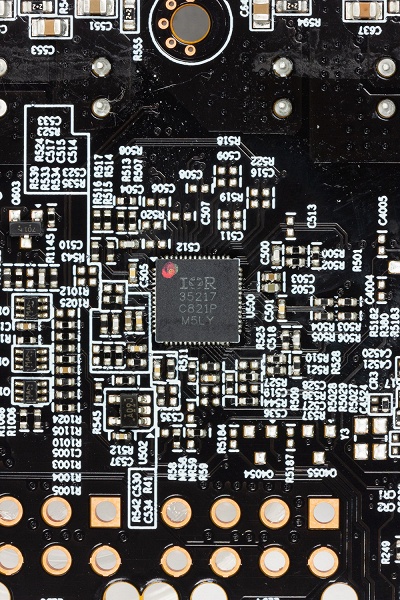
and consist of seven assemblies of the DrMOS type.
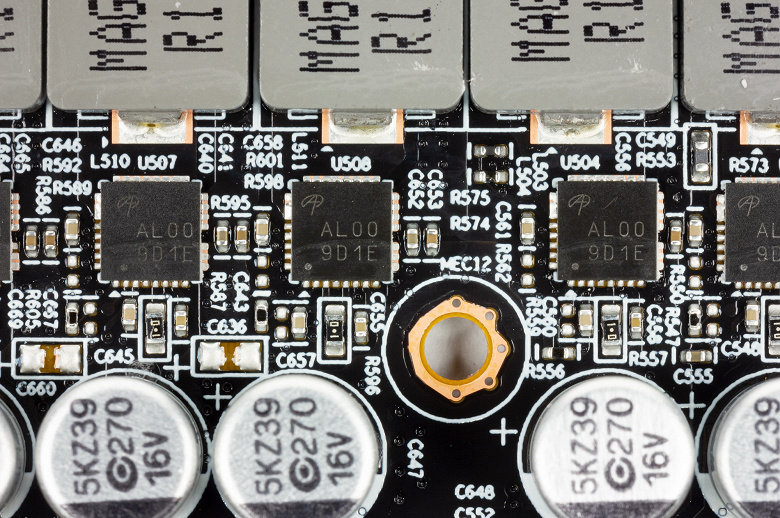
Also on the front side there is another PWM controller (On Semiconductor NCP81022),
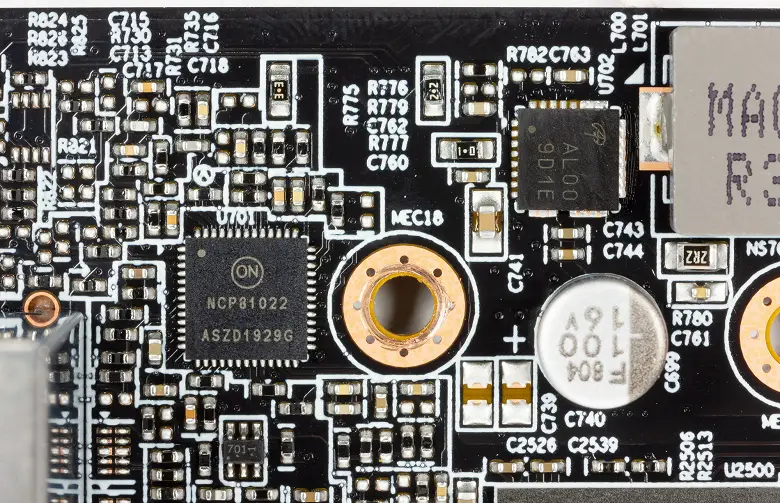
which controls the 4-phase power supply of the memory chips (marked in red).
There is also a controller for backlight control and monitoring.
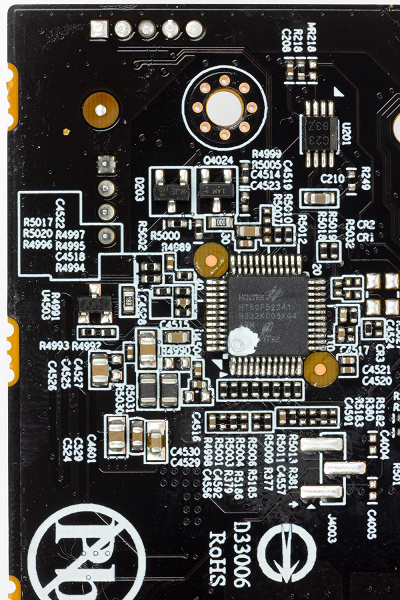
The board has a switch that selects the BIOS boot profile. You can set the operating mode at the maximum factory set frequencies (Performance), but the CO will work a little louder. And you can change the mode to “quiet” (Silent), the frequencies will drop to the reference values, the CO will become quieter. The default is Performance mode.
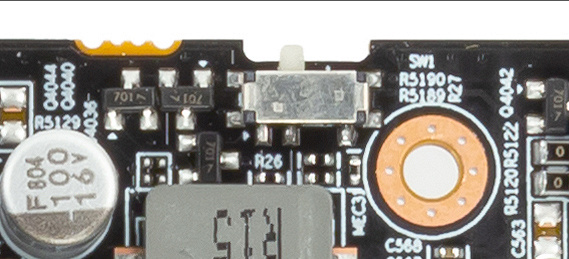
The nominal memory frequencies in both cases are equal to the reference values, but the core frequency in Performance mode is higher, which, as it turned out during testing, provides a performance gain of around 5%.
The Gigabyte board has an unusual set of video outputs: three DisplayPort and three HDMI. Thus, the company has implemented AMD Eyefinity 6 technology, long forgotten by many AMD partners, which allows displaying images on 6 monitors. Few people know that each AMD GPU has had 6 transmitters for a long time, but usually 4 of them were reserved for two Dual-Link DVI outputs, now DVI connectors are becoming less common, and you can safely use transmitters for DP / HDMI. However, even a standard set of 4 video outputs is almost never fully used by anyone, so AMD partners logically decided not to bother with complicating the layout of printed circuit boards to organize six video outputs. Nevertheless, in this case we see exactly the full implementation of AMD Eyefinity, this is a peculiar feature of the Gigabyte card.
Power is supplied through two 8-pin connectors.
Management of the card is provided using the proprietary utility Aorus Engine.
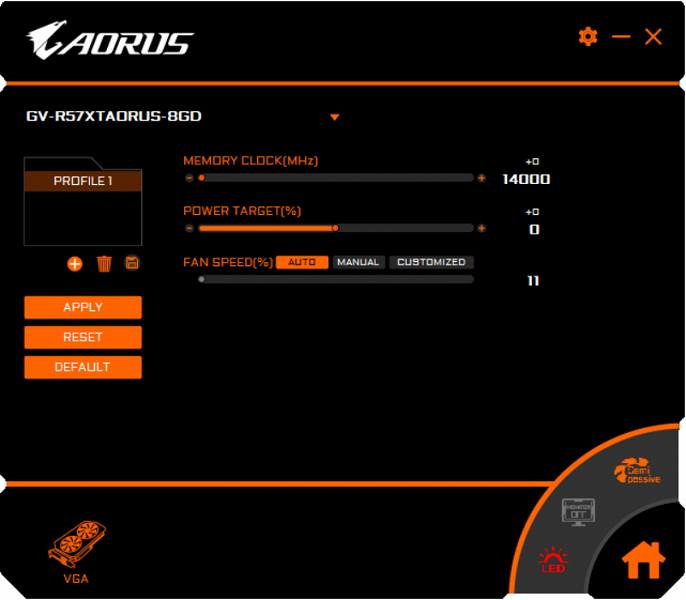
In general, nothing special: the usual set of frequency control, operating modes of CO and backlight (more on that below).
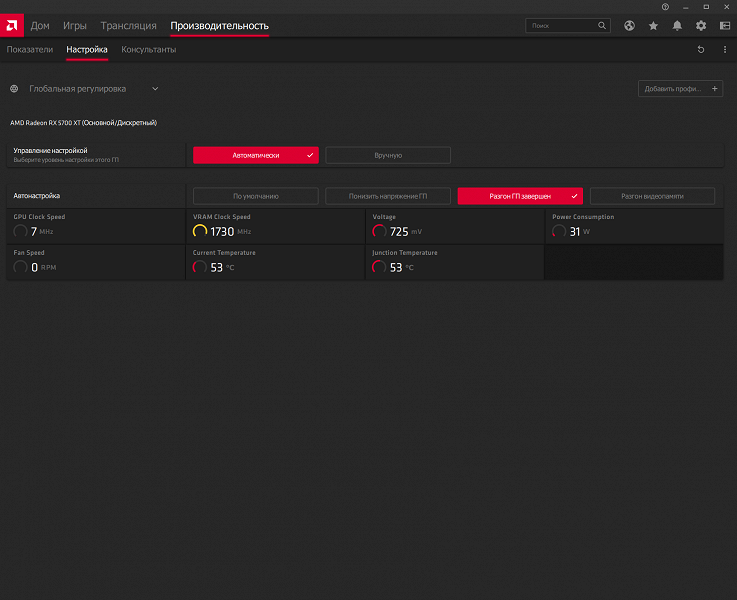
Radeon RX 5700 XT – the accelerator is hot, its frequencies are raised by AMD itself almost to the limit. In this case, it is not necessary to speak with confidence about a serious gain from overclocking, and therefore I followed the path of most advanced users and used AMD’s standard tools: auto-overclocking in the driver settings. In principle, it turned out well: the maximum core frequency increased from 1990 to 2081 MHz. However, this is precisely the maximum frequency; in real life it can be achieved only periodically. A correct estimate of the speed gain can only be made on the basis of practical tests.
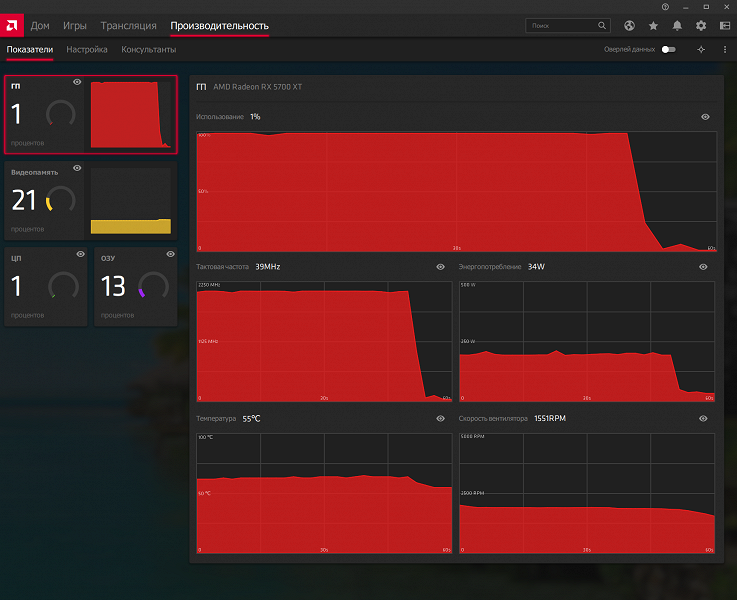
Heating and cooling
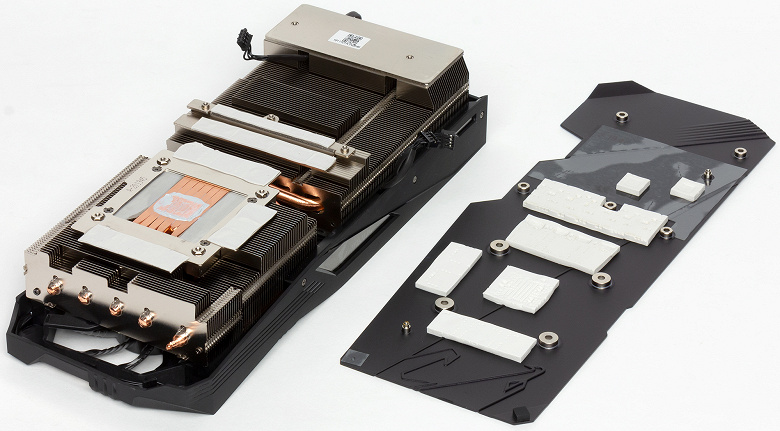
Before us is a traditional cooler of the Windforce series, which is a two-section radiator with plate fins, all parts of which are pierced with heat pipes that press directly onto the GPU chip. The base of the main heatsink has a thermal interface for cooling memory chips. The sole on the second part of the radiator is pressed against the power elements of the power converter. A thick plate is installed on the back of the card, which serves not only as a stiffener, but also as a PCB cooler.
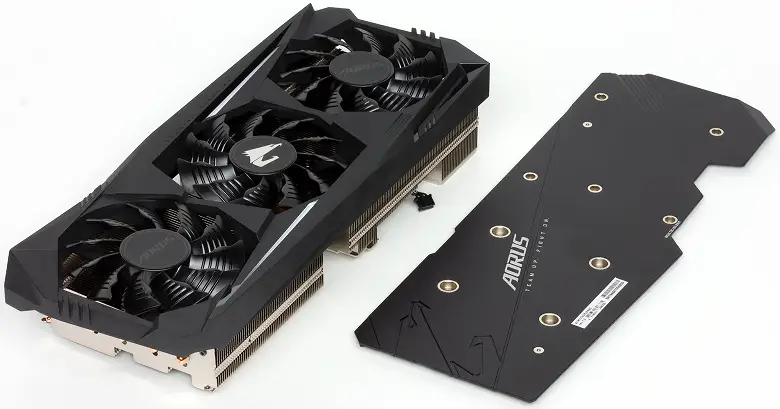
Above the radiator, there is a shroud with three ∅95 mm fans with a special blade profile, which, in theory, helps to reduce noise.
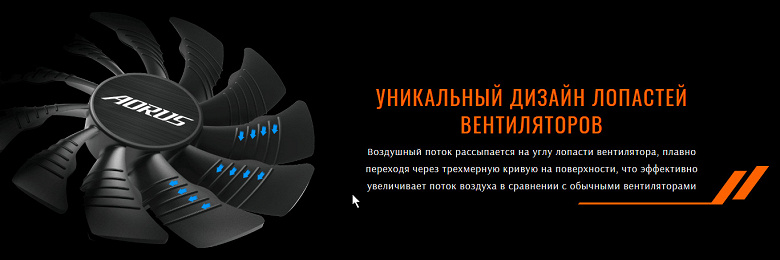
The fan system has the patented Alternative Spinning technology – when the middle fan rotates in the opposite direction, improving the blowing of the cooler heatsinks.
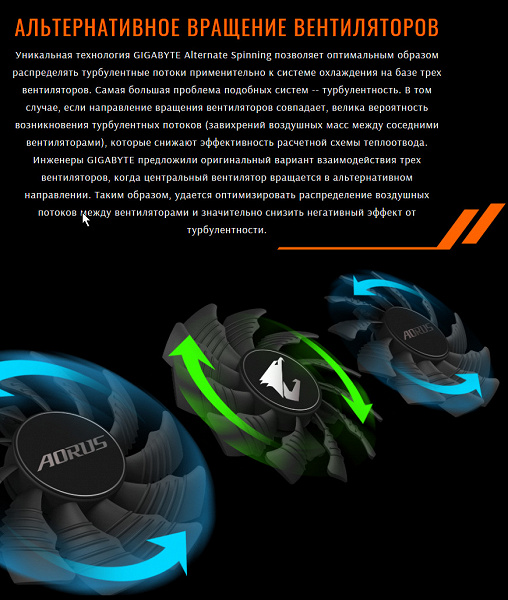
The cooler stops the fans if the GPU temperature drops below 55 degrees. Of course, the CO becomes silent at the same time.
When the PC starts up, the fans work, but after loading the video driver, the operating temperature is polled, and they turn off (this can be seen in the video below). Let me emphasize: this does not depend on the selected BIOS mode (Performance / Silent).
Thermal Monitoring with MSI Afterburner:
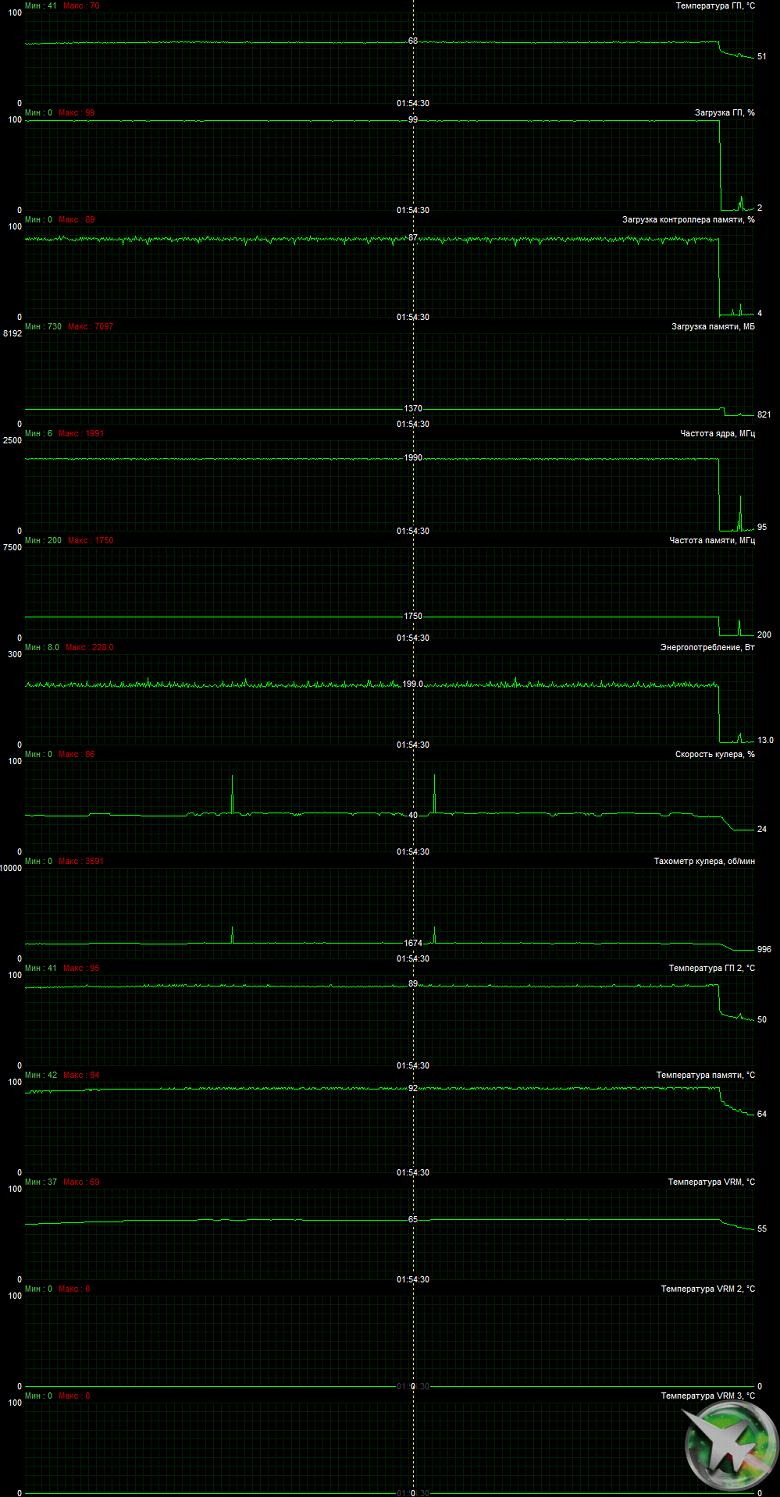
After a 6-hour run under load, the maximum core temperature did not exceed 68 degrees, which is a very good result for a video card of this level.
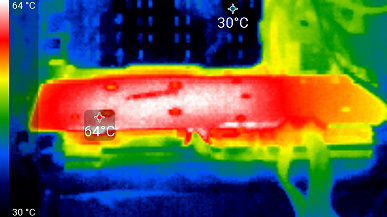
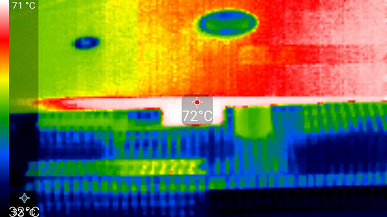
Maximum heating – the central area of the PCB near the GPU and power converters.
During auto acceleration, the temperature parameters almost did not change, but the CO revolutions increased slightly.
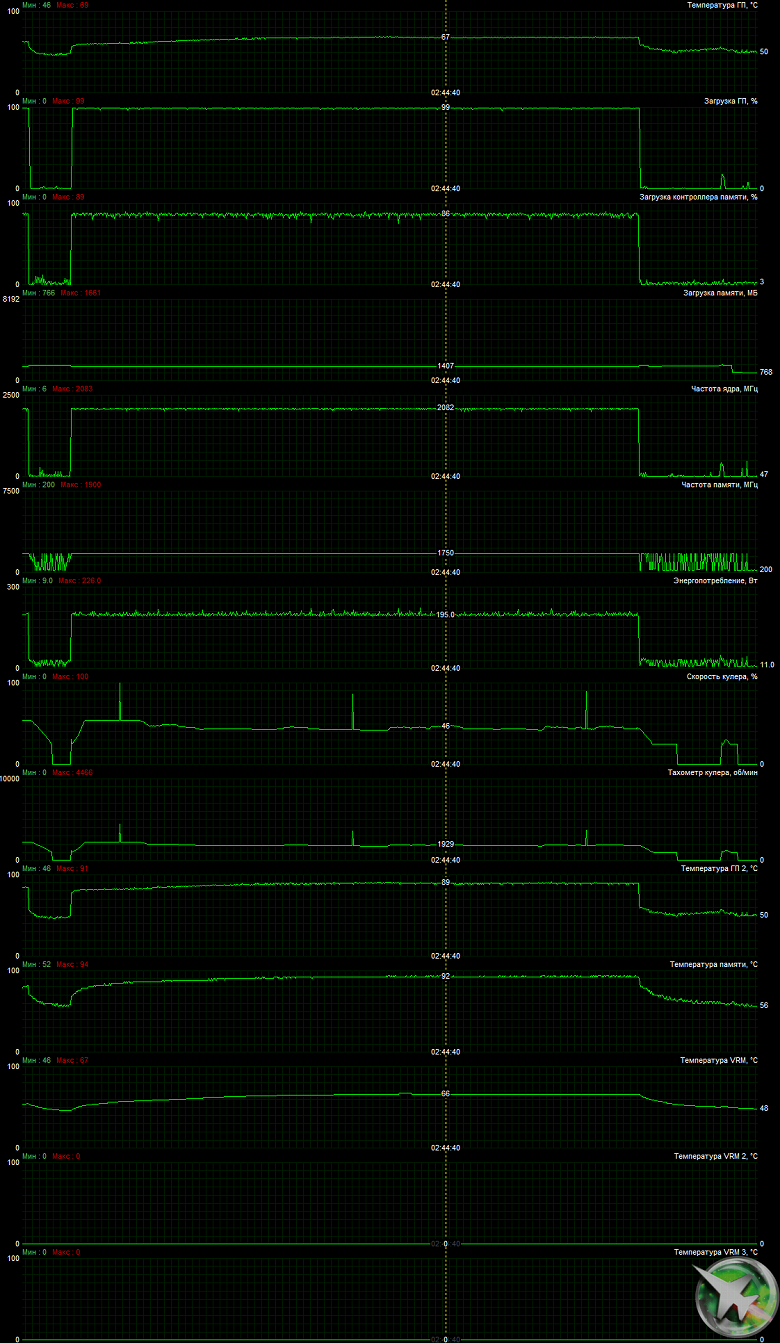
Noise
The noise measurement technique assumes that the room is noise-insulated and damped, and reverberations are reduced. The system unit, in which the noise of video cards is examined, does not have fans and is not a source of mechanical noise. The background level of 18 dBA is the noise level in the room and the noise level of the sound level meter itself. Measurements are taken from a distance of 50 cm from the video card at the level of the cooling system.
Measurement modes:
- Idle mode in 2D: loaded internet browser with iXBT.com website, Microsoft Word window, a number of internet communicators
- 2D mode with movie viewing: SmoothVideo Project (SVP) is used – hardware decoding with insertion of intermediate frames
- 3D mode with maximum load on the accelerator: using FurMark benchmark
The assessment of the noise level gradations is as follows:
- less than 20 dBA: conditionally silent
- 20 to 25 dBA: very quiet
- from 25 to 30 dBA: quiet
- 30 to 35 dBA: clearly audible
- 35 to 40 dBA: loud but bearable
- above 40 dBA: very loud
In 2D idle, the temperature was 35 ° C, the fans were not rotating, the noise level was equal to the background noise.
When watching a movie with hardware decoding, nothing changed, the noise remained at the same level.
Under maximum load in 3D (no overclocking), the temperature reached 68 ° C. At the same time, the fans spun up to 1674 rpm, the noise rose to 29.0 dBA, which is relatively quiet.
When the sound is accelerated by 10 times in the video above, we see that with an increase in the load on the GPU, the increase in the noise level from CO occurs rather smoothly and just as smoothly decreases when switching from 3D to 2D mode.
But during overclocking, the situation is a little different: the noise level rises faster, and in general the level is slightly higher.
Backlight
It’s amazing how much more modest light at Aorus cards based on Radeon compared to similar solutions on the base of GeForce.
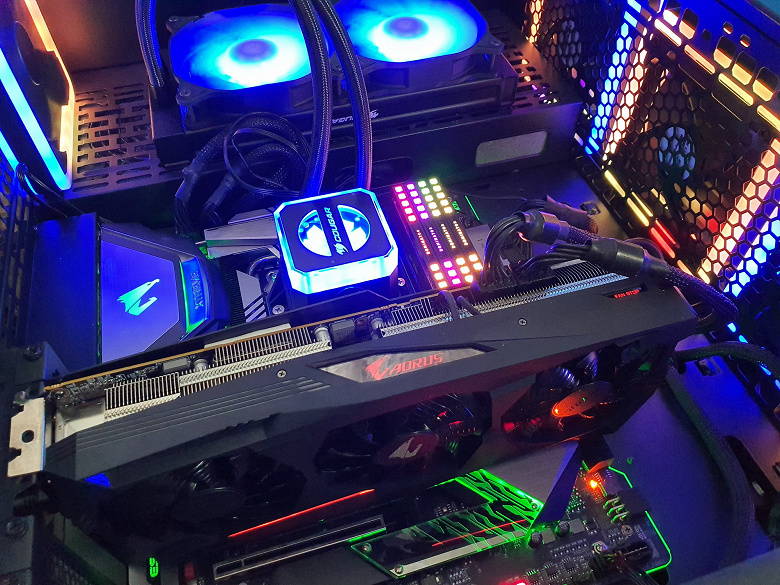
Where are the fan impeller lights? Here only the logo on the upper end is lit, the fan stop indicator is in the same place and several stripes above and below the fans.
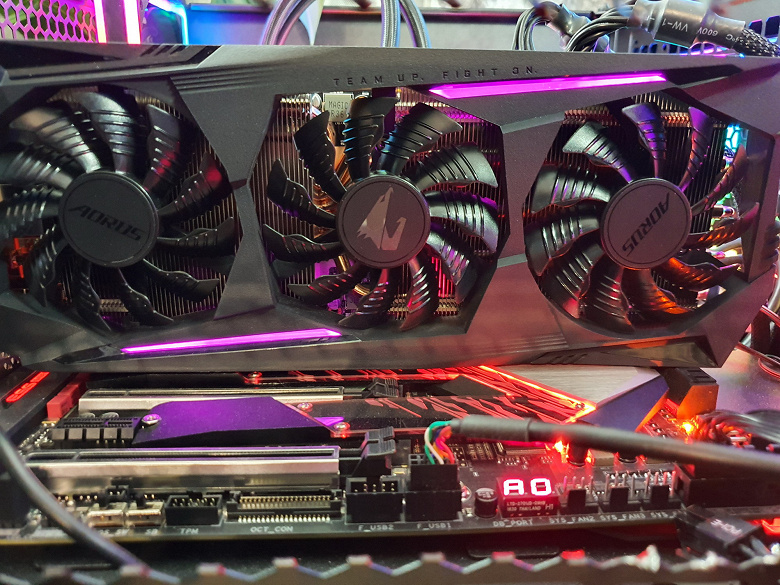
Sneaking suspicion that Aorus having fun on Nvidia’s management, because the difference is so noticeable. Compared to the rich backlighting of top modern motherboards and cases, this solution looks very modest, and this is noticeable in the video.
The backlight can be controlled via the RGB Fusion 2.0 app, which you can install yourself, or via the aforementioned Aorus Engine utility.
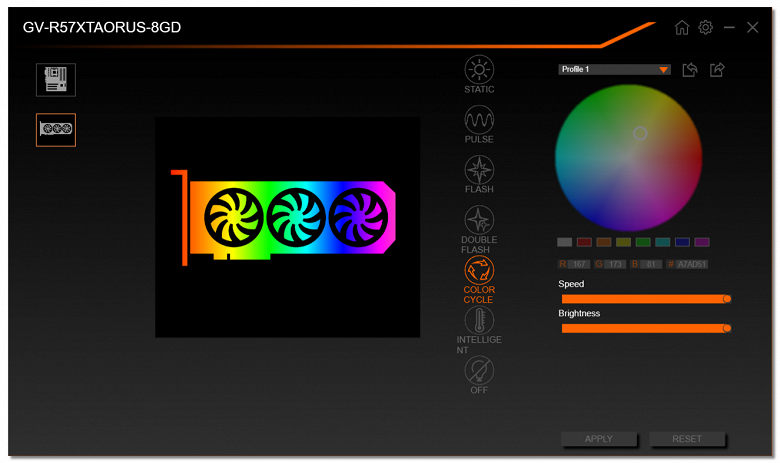
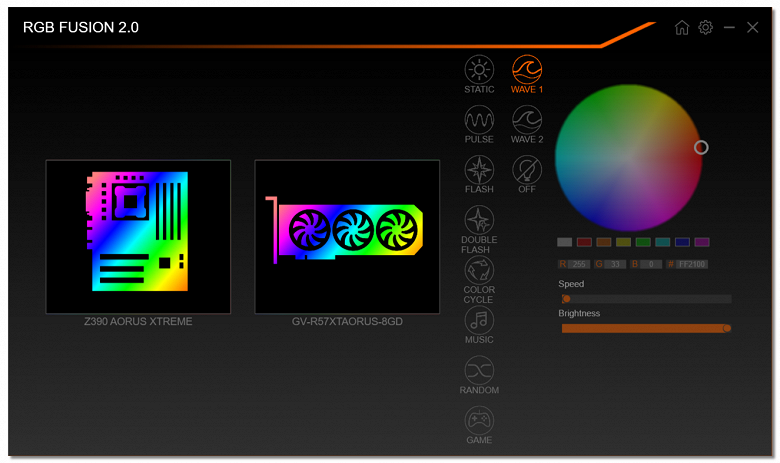
Scope of delivery and packaging
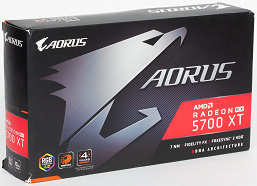
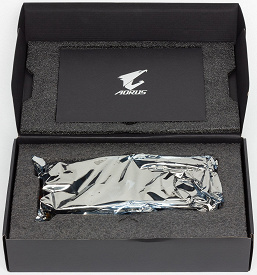
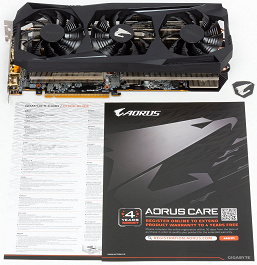
The basic package should include a user’s manual, media with drivers and utilities. We see the basic kit, plus a branded sticker.
Test results
Test bench configuration
- Компьютер на базе процессора Intel Core i9-9900K (Socket LGA1151v2):
- процессор Intel Core i9-9900K (разгон до 5,0 ГГц по всем ядрам);
- ЖСО Cougar Helor 240;
- системная плата Gigabyte Z390 Aorus Xtreme на чипсете Intel Z390;
- оперативная память Corsair UDIMM (CMT32GX4M4C3200C14) 32 ГБ (4×8) DDR4 (XMP 3200 МГц);
- SSD Intel 760p NVMe 1 ТБ PCI-E;
- жесткий диск Seagate Barracuda 7200.14 3 ТБ SATA3;
- блок питания Corsair AX1600i (1600 Вт);
- корпус Thermaltake Versa J24;
- операционная система Windows 10 Pro 64-битная; DirectX 12 (v.1903);
- телевизор LG 43UK6750 (43″ 4K HDR);
- драйверы AMD версии 20.1.1;
- драйверы Nvidia версии 441.87;
- VSync отключен.
Testing tool list
All games used the maximum graphics quality in the settings.
- Gears 5 (Xbox Game Studios/The Coalition)
- Tom Clancy’s The Division 2 (Massive Entertainment/Ubisoft)
- Devil May Cry 5 (Capcom/Capcom)
- Red Dead Redemption 2 (Rockstar)
- Star Wars Jedi: Fallen Order (Electronic Arts/Respawn Entertainment)
- Shadow of the Tomb Raider (Eidos Montreal/Square Enix), HDR включен
- Metro Exodus (4A Games/Deep Silver/Epic Games)
- Strange Brigade (Rebellion Developments/Rebellion Developments)
Tom Clancy’s The Division 2
Star Wars Jedi: Fallen Order
Shadow of the Tomb Raider
Ratings
IXBT.com Rating
The iXBT.com accelerator rating shows us the functionality of video cards relative to each other and is normalized for the weakest accelerator – Radeon RX 550 (that is, the combination of speed and functions of RX 550 is taken as 100%). Ratings are carried out for 28 accelerators that we study monthly as part of the Best Video Card of the Month project. A group of cards for analysis is selected from the general list, which includes the RX 5700 XT and its competitors.
Retail prices as of mid-February 2019 were used to calculate the utility rating .
| № | Accelerator model | IXBT.com Rating | Utility rating | price, rub. |
|---|---|---|---|---|
| 04 | RTX 2070 Super 8 ГБ, 1605—1950/14000 | 1220 | 385 | 31 700 |
| 05 | Aorus RX 5700 XT 8 GB, overclocking to 2082/14000 | 1160 | 386 | 30 000 |
| 06 | Aorus RX 5700 XT 8 ГБ, 1770—1990 / 14000 | 1140 | 380 | 30 000 |
| 08 | RX 5700 XT 8 GB, 1605—1905 / 14000 | 1090 | 419 | 26 000 |
| 09 | RTX 2070 8GB 1410-1850 / 14000 | 1040 | 378 | 27 500 |
| 10 | RTX 2060 Super 8 ГБ, 1470—1950/14000 | 1040 | 424 | 24 500 |
The increased operating frequency of the Gigabyte card (in Performance mode) provides it with a noticeable increase in speed, up to 5%, and with auto overclocking, another couple of percent of performance is added. As a result, the card became even closer to the RTX 2070 Super, and even caught up with the competitor in a number of tests.
Utility rating
The utility rating of the same cards is obtained if the iXBT.com rating indicators are divided by the prices of the corresponding accelerators. Taking into account that the Radeon RX 5700 XT is aimed at a resolution of at least 2.5K, we give the rating for this resolution, it differs from the overall rating for the three resolutions .
| № | Accelerator model | Utility rating | IXBT.com Rating | price, rub. |
|---|---|---|---|---|
| 02 | RTX 2060 Super 8 ГБ, 1470—1950/14000 | 434 | 1063 | 24 500 |
| 04 | RX 5700 XT 8 GB, 1605—1905 / 14000 | 417 | 1085 | 26 000 |
| 06 | RTX 2070 Super 8 ГБ, 1605—1950/14000 | 392 | 1243 | 31 700 |
| 07 | Aorus RX 5700 XT 8 GB, overclocking to 2082/14000 | 385 | 1157 | 30 000 |
| 08 | RTX 2070 8GB 1410-1850 / 14000 | 380 | 1045 | 27 500 |
| 09 | Aorus RX 5700 XT 8 ГБ, 1770—1990 / 14000 | 378 | 1135 | 30 000 |
At the time of this review, the weighted average prices for the GeForce RTX 2060 Super were still slightly lower than for the Radeon RX 5700 XT, so the Nvidia accelerator is still the leader in its group, however, the RX 5700 XT lags insignificantly, and the reference card based on this GPU took the second position. But the cost of the Gigabyte card at the time of publication of the article was clearly overestimated, it was inferior to the more expensive RTX 2070 Super, and even (in the basic version, without overclocking) the old RTX 2070. We are waiting for the RX 5700 XT in non-reference versions to boast a more attractive ratio opportunities and prices.
Again, it must be reiterated that the utility rating only takes into account pure performance (with caveats), and things like noise, lighting, design, and set of video outputs are not counted by definition.
conclusions
Gigabyte Aorus Radeon RX 5700 XT 8G (8 GB) is an interesting version of the Radeon RX 5700 XT and, in general, a good example of a gaming-grade 3D graphics accelerator with a price of around 30,000 rubles. At the time of this review, this Gigabyte accelerator showed almost the same performance as the GeForce RTX 2070 Super, although the latter has the added advantage of RT support. The leader in our utility rating, the GeForce RTX 2060 Super, is not ideal for use at 2.5K with maximum graphics quality, but the Radeon RX 5700 XT feels great in games at this resolution. As prices fall, it will be possible to safely recommend the RX 5700 XT for purchase, but at the moment we get a purely “religious” choice: RTX or RX 🙂
The reviewed Gigabyte card has an excellent cooling system, quite quiet even under maximum load, and under low load it is generally silent, but a card with such CO occupies three slots in the system unit. If the performance is enough for you, the card can be switched to the “quiet” mode of operation, further reducing the CO noise. The card has backlighting, but the set of lighting effects is scarce. As a plus, it is worth mentioning the presence of proprietary software Aorus Engine, which allows you to quickly change the operating mode. Also, it should be noted a unique set of video outputs: there are as many as six, so you can connect up to six monitors and enjoy the work of AMD Eyefinity technology. We repeat that the Radeon RX 5700 XT as a whole provides the player with complete comfort at maximum graphics settings at a resolution of 2560 × 1440 in all games, and in a number of games you can try to play with the same graphics quality in 4K.





